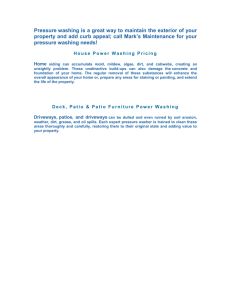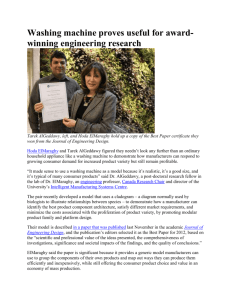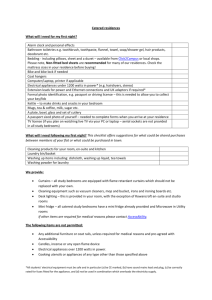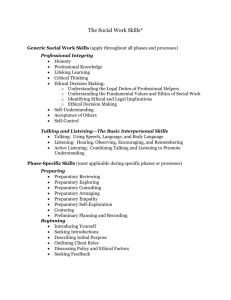Welcome And Introduction
advertisement
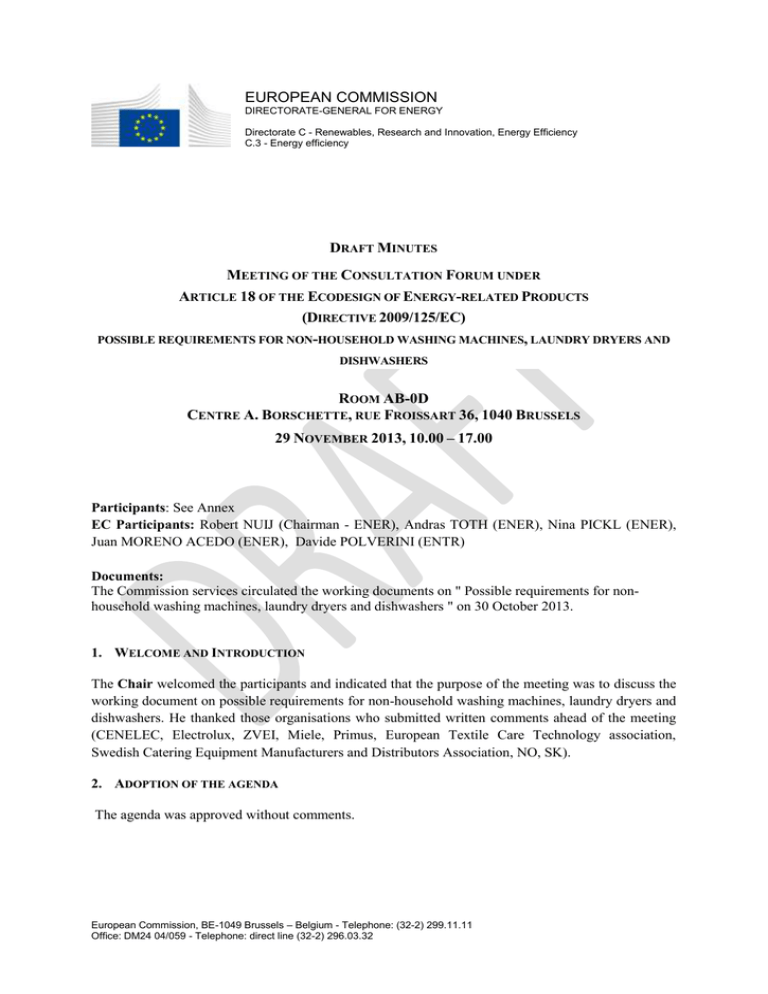
EUROPEAN COMMISSION DIRECTORATE-GENERAL FOR ENERGY Directorate C - Renewables, Research and Innovation, Energy Efficiency C.3 - Energy efficiency DRAFT MINUTES MEETING OF THE CONSULTATION FORUM UNDER ARTICLE 18 OF THE ECODESIGN OF ENERGY-RELATED PRODUCTS (DIRECTIVE 2009/125/EC) POSSIBLE REQUIREMENTS FOR NON-HOUSEHOLD WASHING MACHINES, LAUNDRY DRYERS AND DISHWASHERS ROOM AB-0D CENTRE A. BORSCHETTE, RUE FROISSART 36, 1040 BRUSSELS 29 NOVEMBER 2013, 10.00 – 17.00 Participants: See Annex EC Participants: Robert NUIJ (Chairman - ENER), Andras TOTH (ENER), Nina PICKL (ENER), Juan MORENO ACEDO (ENER), Davide POLVERINI (ENTR) Documents: The Commission services circulated the working documents on " Possible requirements for nonhousehold washing machines, laundry dryers and dishwashers " on 30 October 2013. 1. WELCOME AND INTRODUCTION The Chair welcomed the participants and indicated that the purpose of the meeting was to discuss the working document on possible requirements for non-household washing machines, laundry dryers and dishwashers. He thanked those organisations who submitted written comments ahead of the meeting (CENELEC, Electrolux, ZVEI, Miele, Primus, European Textile Care Technology association, Swedish Catering Equipment Manufacturers and Distributors Association, NO, SK). 2. ADOPTION OF THE AGENDA The agenda was approved without comments. European Commission, BE-1049 Brussels – Belgium - Telephone: (32-2) 299.11.11 Office: DM24 04/059 - Telephone: direct line (32-2) 296.03.32 3. WORKING DOCUMENT ON POSSIBLE REQUIREMENTS FOR NON-HOUSEHOLD WASHING MACHINES, LAUNDRY DRYERS AND DISHWASHERS The Commission presented the working documents (see annexed presentation). Apart from describing the proposed requirements, it highlighted in what way they differ from previous ecodesign measures: 1. Even though common measurement standards and test results are largely unavailable for the product groups concerned, the Commission did not want to delay progress until they become available. Therefore a special staging of the requirements is proposed. The Commission would mandate European Standardisation Organisations to develop the measurement methods that are needed. The regulation to be adopted now would provide that only product information requirements start applying 3 years after entry into force, after the measurement methods have become available. On the basis of the information communicated, the Commission would be able to verify in a review scheduled after 4 years whether the minimum requirements adopted on the basis of data in preparatory study, and in principle applicable after 5 years, would still be appropriate. The certainty that minimum requirements will apply in 5 years and, unless contradictory information is provided, their value will remain the same, should provide an incentive for manufacturers and standardisation organisations to deliver measurement methods speedily. 2. A special procedure is proposed for market surveillance of industrial products such as tunnel washers, which are always tailor-made and assembled on site. In case of doubt after looking into the technical documentation, the authorities would be able to go on the site of an already installed equipment and test (with as little disruption as possible to the business of the owner) whether the equipment complies with the requirements. If not, the manufacturer would get a chance to correct the installation, and only if it fails in a second test, would have to be withdrawn. The Commission also noted that the energy saving potential estimated in the explanatory note is different from the one presented today, because the consultant VHK are in the process of consolidating the scenario analyses of all the ecodesign preparatory studies into a single model. They have made some corrections to the scenario analysis of the products discussed today. Written comments on the working documents are welcome until 6 January 2014. During the ensuing discussion, the following points were raised: AT: The complexity of the package (putting all the products in one regulation) might lead to undue delays for those products on which we could act faster. Tunnel washers are sold in low numbers, no market surveillance would take place on them. Perhaps we could require only product information. It is clear that standards are to be developed first, but what could be the tiers for the finalisation of the standards? IT: The current construction does not work. It is a clustering of different products and energy sources. We should divide in a vertical way between product types, then distinguish commercial, industrial, and professional. Take the most promising products, do one measure, check if regulation works. We need to decide on such scope issues first, before we discuss technical details. DE: The Commission wants the regulations to do the job of the study, i.e. gather info. The timing is stretched, after measurement methods are developed, there is only one year to gather data, and then one year before entry into force of the current requirements. The legislative process for the intermediate review will take longer than this. NL: Agrees with AT and IT, except on the necessity to treat appliances using different energy sources separately. This is not a voluntary measure, we should make sure standards and data are available, 2 regulation should come only after that. A review before the requirements enter into force would have perverse effects. Let’s not push this regulation just because anything is better than nothing. Consultation Forum meetings take a lot of time to prepare and manage. Considerations of such general issues on scope and whether to act should have been done in the preparatory study. When we take off in CF, we should already know where we land to avoid wasting time and resources. UK: In a first instance, only benchmarks should be set. Otherwise we will have the same sort of problems as with lighting products. DK (supported by SE): Regulation is a good way to collect data, but timing is too short, there could be an extension of stage 1 or 2 by a year. Splitting up the regulations may be logical, but then their adoption is also more time-consuming. IT: Supports NL. For such products, short feasibility study should be done even before the preparatory study. An expert group could now look into what to do with these products before we table another proposal. COM: Notes that nowadays the study preparing the priority product list for the Working Plan can be considered a feasibility study, and for conditional products such as thermal insulation, dedicated exploratory studies are launched before the preparatory study. Agoria: There is nothing in the working document on top-loading washing machines, neither on the impact of soap suppliers on washing programmes, as they determine water use, the length of the cycle, temperature etc. What is the point of having an energy efficiency requirement if it is destroyed by the soap supplier? There is also a conflict of interest for coin shop owners, who are interested in having the linen as wet as possible when out of the washing machines, in order to sell drying time. Van Holsteijn en Kemna (VHK, Commission consultants for the impact assessment): the top loading machine was not included in the preparatory study, there seemed to be a consensus not to cover them. Detergents are important in tuning the equipment, but the machine is not placed on the market by the detergent supplier. Ecodesign cannot regulate every application, it targets which products can be placed on the market. CENELEC laundry equipment: the performance standard on washing machines and driers is well advanced, there is already a draft for electric appliances. They are waiting for the wording of the regulations to draft Annexes ZA and ZZ in the standard. On gas appliances, they have been trying to contact CEN TC 299 without success. For steam heated appliances, the instruments are not accurate enough to measure steam energy to be comparable with electric appliances. There might be delays on that side due to this. Environmental Citizens’ Organisation for Standardisation (ECOS): wonder why the standards were not drafted after the completion of the preparatory study which flagged their absence. Splitting the regulation in order to prioritise could be an option. The professional refrigeration product group was also split, and only 3 of the original 5 product categories were put forward for regulation. European Textile Care Technology (ETCT): Claim to represent 75-80% of heavy duty laundry equipment manufacturers. The preparatory study provides the best guidelines against which to check products. ETCT companies are now testing with ISO 9398, which is the only existing performance standard. In the middle of next year they will have tested all products categories in base cases 1-7, both washing machines and driers. The limit between household and non-household equipment should be 40 kg capacity. For the verification procedure it is important to note that their products are made to order for laundries that often handle 6000 kg / day. Timeline for completing of standardisation: another six machines to be tested until April. They measure machines under real life conditions. Electrolux: They have 700 models to test, too many variants. If extrapolations were to be allowed, still 200 models would have to be tested. A lot of time is needed to go through initial testing, upfront task is big. They do not see the need to test differently below and above 40 kg, it might have a 3 perverse effect. There was a definition change compared to the preparatory study: merging several base cases into one single tank dishwasher category seems indeed problematic, it covers very different appliances. CENELEC laundry equipment: Revising existing standards takes 4-5 years. The ISO standard needs to be seriously adapted; CEN TC 214 would like to start the work on corresponding CEN standard. ESOs are limited in what can do in a given time, timeline should be reconsidered. Miele: Agree that standardisation timeline is critical. They support treating the washing machine base cases in groups, as they use different measurement procedures. End customer is key in determining testing conditions, but products have to remain comparable. Primus: The washing machines running on hot water input are a special case. With combination of electricity, gas and steam, there are too many variants to test. VHK: There could be a point in returning to the 7 dishwasher base cases of the preparatory study. Pot and utensil machines are indeed different and they have to be separated from single tank. Conveyor types can be perhaps modelled into a single group. Electrolux: Support treating pot machines separately, as the number of dishes and amount of water is different. NL: If there is external production of hot water, it is probably already covered by the water heater regulation. The design of the machine is the aspect we should try to influence. Have ETCT thought about proposing a voluntary agreement? They have a high market share with tailor-made products that are difficult to regulate otherwise. ETCT: they are medium sized companies who could not afford the bureaucracy of a voluntary agreement, where a lot of reporting has to take place. They prefer the regulatory approach, which also gives more security. IT: The way forward is: 1. Define product categories. 2. Look where we stand with standardisation in each category. 3. See if household approach can be extended to non-household products and if yes in how much time. Products could be grouped according to feasibility and length of standardisation. We should have a practical approach, not stick to the preparatory study grouping and categorisation. But we first need a table summarizing where we stand with each base case, so as to decide from which moment in time we can require test data from manufacturers, either on the basis of harmonised standards or on the basis of transitional methods. CENELEC: It is difficult to define the categories commercial - professional - industrial. Sometimes the same product is placed on the market for the different applications. Supports a change of terminology to 'non-household', as it covers all of these categories. CENELEC dishwasher committee: The preparatory studies are of good quality. It is a good idea to treat dishwashers separately. Everyone agrees on the 6 dishwasher base cases, unlike in the case of laundry equipment. CLC 59 WG 2.1 has been doing good work focusing on base cases 2 and 3 for two years, starting from zero. It is not possible to cover all base cases with one standard, but for example base cases 2 and 3 can be put together. At the end of 2015 they can be finished with the standards. DE: In order to easily draw the line between household and non-household, they suggest considering products covered by the Low-Voltage Directive as household, and the ones by the Machinery Directive as non-household. The latter applies even to the commercial equipment found in coin shops or in apartment buildings. In terms of market surveillance, they doubt that inspection at a customer’s site is possible, as the level of precision would be low due to lack of laboratory conditions. NL: How about using third party certification for products not measurable in the lab? It could give more information on the product. There are indeed issues with the in situ verification proposed in the draft: if the equipment does not comply, what happens then? Should all the machines of the same type 4 be withdrawn? A more process-oriented verification would be justified in this case, as larger machines bring larger savings per machine. IT: We should clarify what we mean by 3rd party certification. Checking the design of a product is perhaps possible, but taking an actual machine for testing is not possible. What matters is not whether verification is done by 3rd party auditor or a market surveillance authority, but who pays for the test. We can forget minimum requirements if we test only design. The owners of big equipment are already interested in energy savings so perhaps requirements are not so important in their case. CENELEC: one of reasons why work has been going on for two years is that they had to stop drafting when they received the draft working document - the standard testing conditions were very different in the draft from the ones in the draft standard. In particular, in the CENELEC draft one special programme is required for testing with specific temperature and washing performance, and then other parameters of the programme can be created by the manufacturer of the application in question. By contrast, in the draft working document, the programme has to be 45 minutes, but that does not take into account the number and variety of real life uses (e.g. products that can use hot water as an input). VHK: Indeed, products using hot water are a problem in terms of standard rating conditions. Even with cold water appliances there is a crucial discussion. We want comparable products, to set thresholds. If all the parameters are free to select, then how can you set a common requirement? CENELEC: They are not afraid to loosen parameters for standard conditions, because if manufacturers have to report essential parameters, then it is not possible to deviate too much from what is currently on the market. We cannot produce a wash programme which is 1 hour longer, or reduce the 60 degree temperature. In coin shops, the priority is to have clean clothes fast, the level of cleanliness matters less. If manufacturers could opt for testing the general programmes that are in their brochures, it would save a lot trouble for them, because they would not need to test their products for all programmes. Washing performance and water consumption requirements need to be fulfilled anyway. For tumble driers, the proposed standard conditions are wrong, as there is no process air at 70 °C. Incoming air is 140-180 °C, outgoing 40, no fixed temperature within. DK: What is ETCT’s experience with in situ testing, what are the tolerances they use, is the test reproducible? One test parameter which we may want to transpose from the household product standard is the water extracting efficiency. ETCT: In in situ testing, it is possible to achieve results which are fairly accurate. In the case of tunnel washers, testing can be done only on one machine. The preparatory study values can be achieved, but each machine is tailor made. AT: Supports IT idea of creating a matrix of the status of standardisation by base case, and not to put too many products in one measure. Customised product groups are unlikely to have verification and the matrix should also identify which products are suitable for regulation from this point of view. BE: Could conformity assessment module A1 be used in this case, whereby the manufacturer could ask a notified body to test his product? IT: The problem is that first notified bodies would have to be designated, as they do not exist under ecodesign. Asks Commission to clarify what 3rd party certification is, how much it costs, in order to have a shared understanding. Commission: The preparatory study did not consider 3rd party certification. How about using the approach under the Construction Products Regulation (CPR) to start only with harmonisation of standards and product information requirements? NL: Experience with CPR has not been positive. Information requirements are possible, but even there we need to see for which products standards are sufficiently developed. Regulation should put pressure on ESOs to develop standards. The lack of cooperation between CEN/CENELEC on 5 electric/gas appliances is worrying as it recalls the water heaters story, where after 10 years the Commission just wrote the standard itself. We do not want to spend 10 years on these products. The threat should be that COM will write the standards if they are not developed. IT: Information requirements: should be mandatory to be provided, but indicative in nature (no verification necessary - which would be a problem without measurement methods). Manufacturers will not be interested in reporting false data, because then regulation will be incorrect. There should indeed be pressure on standardisation through a time limit. If after a certain number of months the standard is not ready, the information would have to be provided according to a transitory measurement method. We should focus such efforts on the most important products. ECOS: Support IT/NL proposal on time limits for standardisation. The latter should make full use of the Ecodesign Coordination Group between CEN/CENELEC, and also the experts and consultants at the disposal of Commission should monitor the standardisation activities. NGOs potentially offer availability in this monitoring. CENELEC – dishwasher: There is no problem in the case of dishwashers between CENELEC and CEN. Gas heating is not important in dishwashing. The base case 2 and 3 standards will be soon ready. In a functioning B2B market, customers know how to calculate energy costs, they will be happy to compare machines when they have the methods and data to do it. CENELEC - laundry equipment: In spite of the temporary difficulties, they are also eagerly awaiting standards. Commission conclusion We are currently not in a position to take the product group forward on the basis of the proposal that the Commission made. The suggested matrix will be developed to see where products stand in terms of scope, standardisation activities, standard testing conditions and options for market surveillance. We would appreciate input from Forum members and stakeholder to this matrix at the latest by 6 January 2014. We will then write up and circulate the matrix to everyone. Going forward with all products together does not appear to be an option, we need different speeds. We will see also how we can stimulate the standardisation process. 4. AOB DE: request an update on the Commission communication covering measurement methods for Lot 1 and 2 (space and water heaters). When will it be ready? Commission: We are busy working on them. The transitional methods should be published early next year. 6 List of written statements from members of the forum (as filed in CIRCABC) Comments received before the meeting 7 ANNEX – Attendance List Commission Services Austria Belgium Czech Republic Germany Denmark France Ireland Italy The Netherlands Norway Sweden The United Kingdom Turkey AGORIA BFS CEN/TC 214 CENELEC ECOS ELECTROLUX ETCT GRANDIMPIANTI HKI KANNEGIESSER LAVATEC MEIKO MIELE Robert NUIJ Andras TOTH Davide POLVERINI Nina PICKL Bernd SCHAEPPI Bram VERCKENS Vlastimil HYKSA Floris AKKERMAN Miriam HÄFELE Arne KÜPER Jan BERGER Andreas HALATSCH Bjarke HANSEN Jorgen Hede KJELDGAARD Evelyne BISSON Mark SWEENEY Milena PRESUTTO Hans-Paul SIDERIUS Stig FOSS Lina KINNING Edward Michael RIMMER Sital NANA Feza HACISEVKI Tim HAMERS Sigvard HOORNAERT Magnus ERICSSON Rolf WIDMER Markus GESSLER Sten ALMSTROEM Stamatis SIVITOS Mattias JOHANSSON Fabio SINATRA Martin RAUCH Pere GIRBAU Erich W. ARENS Umberto BULF Volker SIEDE Britta RUMMLER Jan-Patrick HARMS Engelbert HEINZ Eckhard SCHAFFITZEL Bruno GAUS Marianne ROEHL 8 PRIMUS VDMA VHK WFK institute Juergen SCHAEFER Matthias KOECKERLING Horst UNSINN Milan JANICEK Petr OPAVSKY Rita NEUMANN Martijn VAN ELBURG Hans COUVEE Thomas HILGERS Hans G. HLOCH 9


